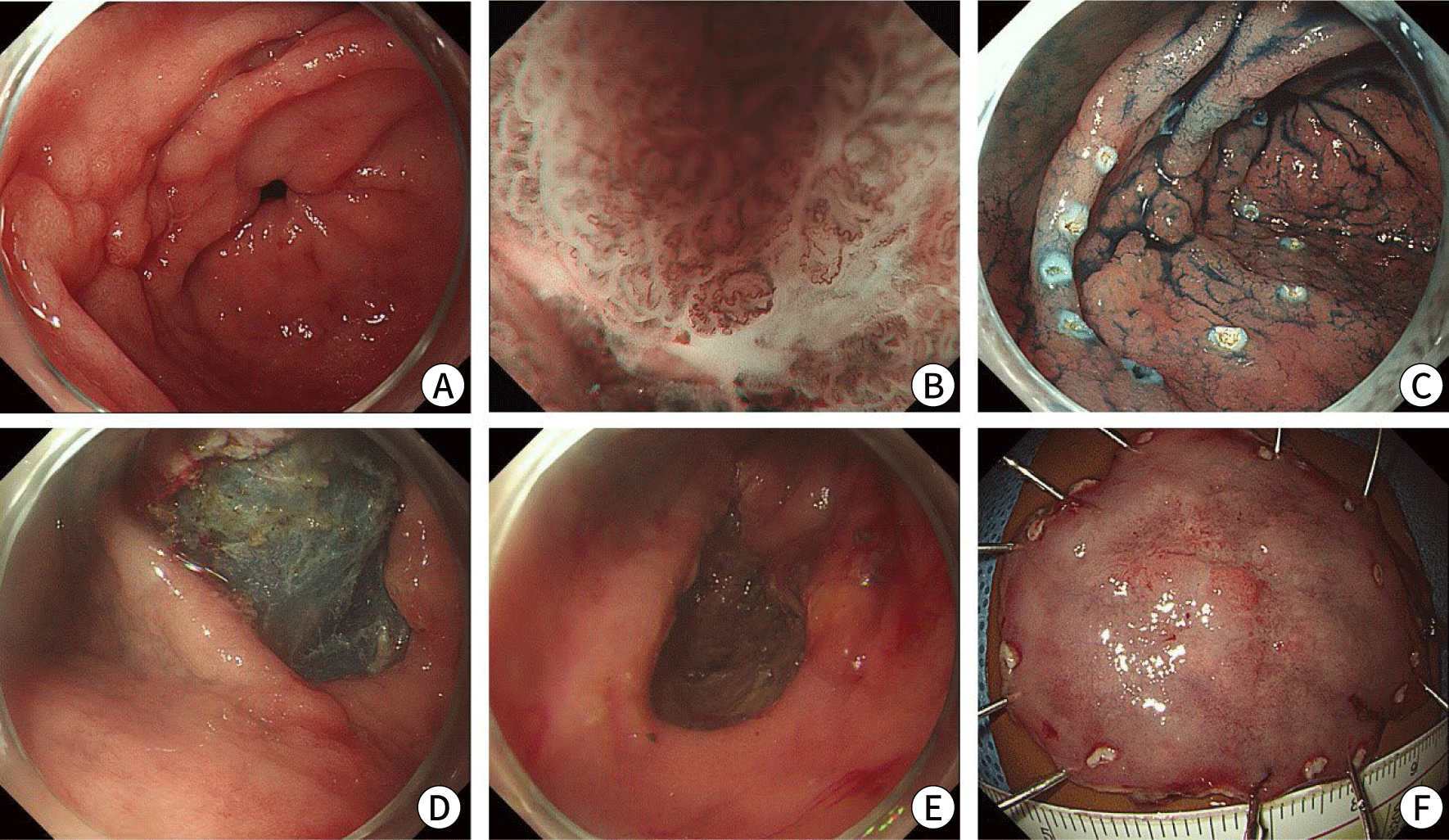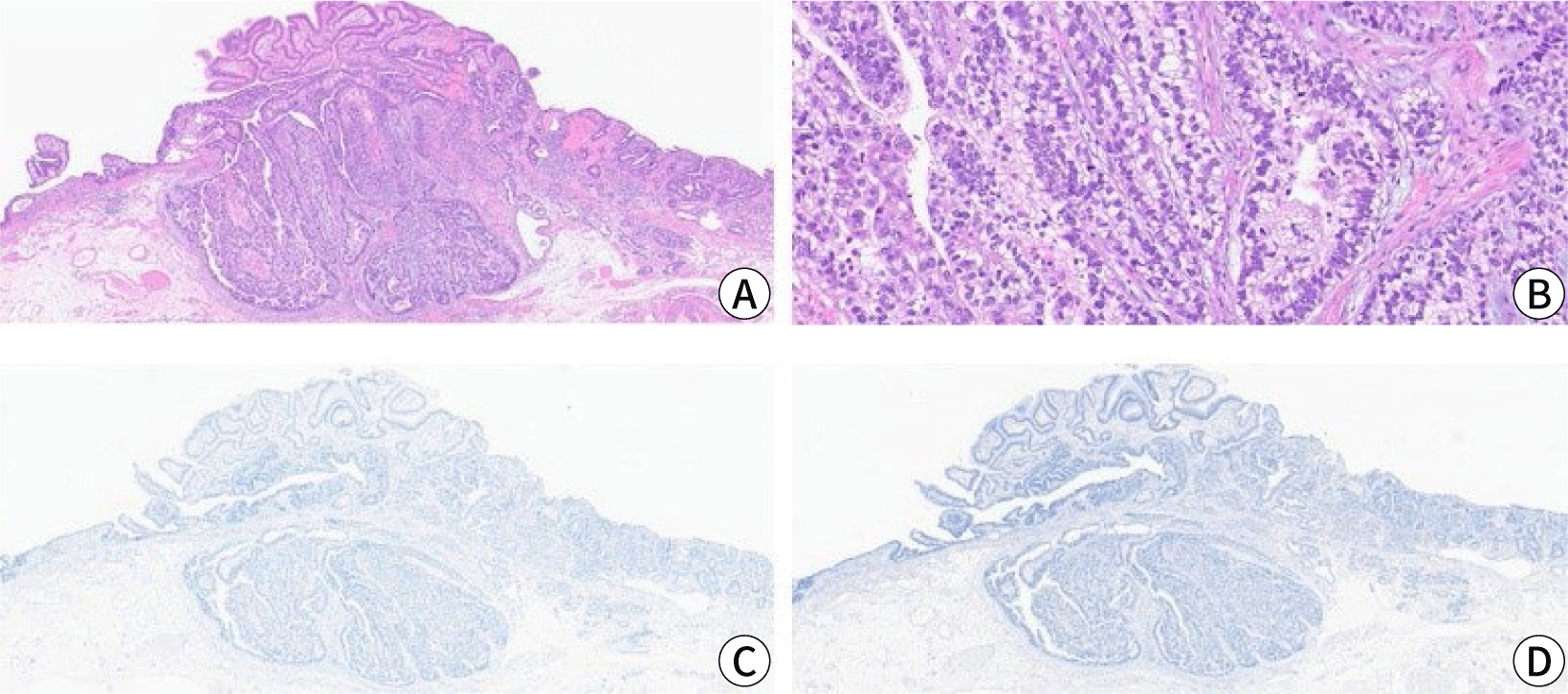Introduction
Gastric adenocarcinoma with enteroblastic differentiation (GAED), also known as clear cell gastric carcinoma, is a rare and poorly documented malignancy, representing less than 1% of all gastric cancers [1,2]. While GAED represents a subtype of alpha-fetoprotein (AFP)-producing adenocarcinomas [1], the relationship between GAED and AFP production is not well understood [2]. Histologically, the tumor is characterized by an intestine-like structure composed of cuboidal or columnar neoplastic cells with clear cytoplasm. These cells test positive for oncofetal proteins, such as glypican-3, spalt-like transcription factor 4 (SALL4), and AFP [3]. GAED tends to be more aggressive than conventional adenocarcinoma, with a higher propensity for lymphovascular invasion and a greater likelihood of metastasis to the liver and lymph nodes (LNs) [4]. In this report, we present a rare case of GAED that was managed with endoscopic submucosal dissection and additional distal gastrectomy with LN dissection.
Case presentation
This case report was granted an exemption from consent and review by the Pusan National University Hospital Research Ethics Review Committee (IRB No. 2402-023-136).
A 67-year-old man visited our hospital seeking treatment for high-grade dysplasia in the stomach, which was identified during esophagogastroduodenoscopy at a health checkup. The patient was asymptomatic. His medical history included alcoholic hepatitis and chronic hepatitis B, along with heavy alcohol consumption and a 40-pack-year smoking history.
Laboratory analysis indicated a slight elevation of liver function test results, suggestive of alcoholic hepatitis. Tumor markers, including serum AFP, carcinoembryonic antigen, and carbohydrate antigen 19–9, were within normal limits. Esophagogastroduodenoscopy revealed a 2-cm slightly depressed lesion with nodular mucosal changes on the anterior wall of the gastric prepylorus (Fig. 1A). Magnifying endoscopy with narrow-band imaging revealed a clear demarcation line and irregular patterns in microsurface (MS) and microvascular (MV) structures, including irregular oval/tubular MS and irregular loop MV patterns (Fig. 1B). Endoscopic ultrasonography indicated that the lesion was confined to the mucosal layer. Abdominal and chest computed tomography revealed no evidence of LN involvement or distant metastases.

Endoscopic submucosal dissection was performed to achieve complete resection of the lesion (Fig. 1C–E). Assessment of the gross appearance of the resected specimen revealed a 19-mm, IIc lesion with an irregular mucosal surface (Fig. 1F). Based on microscopic examination, the tumor exhibited a tubulopapillary growth pattern along with submucosal invasion (Fig. 2A). The tumor was overlaid by conventional adenocarcinoma and was partially composed of cuboidal or columnar cells with clear cytoplasm, a feature reminiscent of the primitive fetal gut and indicative of enteroblastic differentiation (Fig. 2B). On immunohistochemical staining, the tumor cells tested negative for glypican-3 and AFP, which are recognized as oncofetal proteins (Fig. 2C, D). Although the horizontal and deep resection margins were tumor-free, the tumor had penetrated the deep submucosa (750 µm from the muscularis mucosa) and exhibited lymphatic invasion. Consequently, additional distal gastrectomy with LN dissection was performed. Examination of the surgical specimens revealed no residual tumor or LN metastasis.

Discussion
GAED, also known as clear cell gastric carcinoma, is a rare entity in the stomach. Clear cell carcinomas are more commonly found in the lower urinary tract and the female reproductive system, specifically the endometrium and ovary. Due to the infrequency of GAED, its clinicopathologic and immunohistochemical features are not yet fully understood [2,5,6]. Histologically, enteroblastic adenocarcinoma often coexists with conventional well-differentiated or moderately-differentiated tubular adenocarcinoma, found in the upper portion of the tumor [2]. GAED is characterized by a tubulopapillary growth pattern, with predominantly clear cells and luminal eosinophilic secretions [7]. In the present case, magnifying endoscopy with narrow-band imaging revealed irregular oval/tubular MS and irregular loop MV patterns. These findings were in line with the histopathological characteristics of GAED, as described in previous reports [8,9].
On immunohistochemical staining, most GAEDs variably express three enteroblastic lineage markers, also known as oncofetal proteins. These markers include glypican-3 (associated with hepatoid gastric carcinoma), AFP (a marker for hepatocellular carcinoma and yolk sac tumor), and SALL4 (a marker for AFP-producing gastric carcinoma) [10−12]. For the diagnosis of GAED, glypican-3 is the most sensitive marker, followed by SALL4 and AFP [2]. In the present case, staining was negative for glypican-3 and AFP, and SALL4 staining could not be performed due to a lack of necessary testing equipment. When immunohistochemical staining reveals AFP production in gastric carcinoma cells, the lesion is classified as AFP-producing gastric carcinoma. This type of carcinoma is associated with a poor prognosis due to a high incidence of lymphovascular invasion and liver metastasis [13].
Clear cells are characterized by an abundant cytoplasm filled with substances such as glycogen, lipid, water, or mucin [6]. Gastric carcinomas with clear cell changes (GCCs) typically display a cytoplasmic accumulation of glycogen and mucin. Our previous research indicated that GCCs secondary to glycogen deposition are associated with the expression of AFP, glypican-3, and CD10. In contrast, GCCs with mucin deposition are linked to the expression of MUC5AC and MUC6 [14]. GAED and hepatoid adenocarcinoma are representative histologic subtypes of GCC. Hepatoid adenocarcinoma with clear cells is distinguished from GAED by its poor prognosis, diffuse and strong expression of oncofetal proteins, and intestinal mucin phenotype [7]. In contrast, GAED exhibits focally heterogenous expression of oncofetal proteins and frequently expresses CD10, CDX-2, and MUC6, but not MUC2 and MUC5AC. These features suggest a gastric antral/intestinal mucin phenotype with focal enteroblastic differentiation [7].
Similar to AFP-producing adenocarcinoma, the presence of clear cell changes in gastric cancer is associated with a poor prognosis compared to conventional gastric adenocarcinoma [14]. Research indicates that most patients with GAED (90%) exhibit lymphatic and/or vascular invasion [2]. LN metastasis is observed in 40% of early-stage cases and 84% of advanced cases, which exceeds the rates observed in conventional gastric adenocarcinoma (20%–45%).
In conclusion, GAED is a rare malignancy characterized by distinct histopathological features. It is more aggressive than conventional adenocarcinoma, with frequent lymphovascular invasion and metastasis to the liver and LNs; consequently, it has a poor prognosis. Clinicians should therefore recognize the histopathological diagnosis of this rare tumor and remain cognizant of its aggressive behavior.

